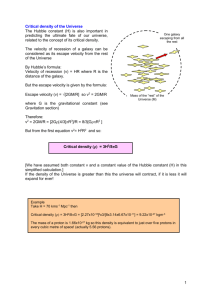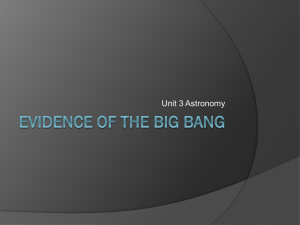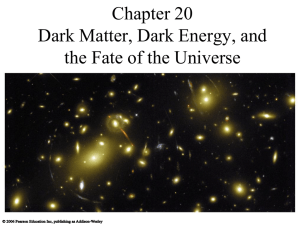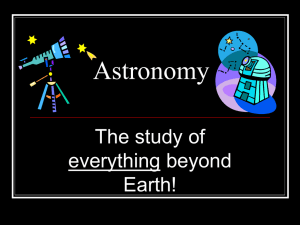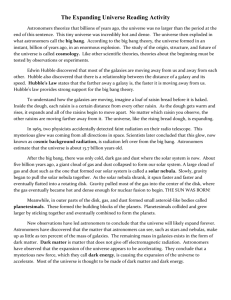8.Thedarkcosmos_llc3_jaya_llc2_ar_llc_ms_llc_corr
advertisement
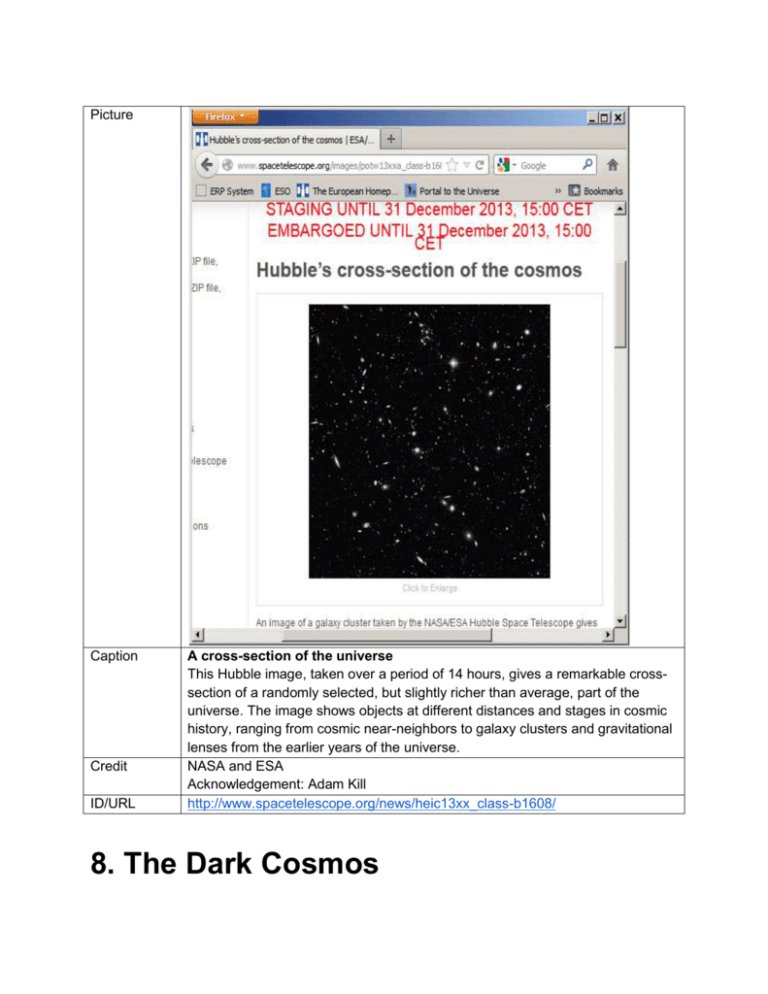
Picture Caption Credit ID/URL A cross-section of the universe This Hubble image, taken over a period of 14 hours, gives a remarkable crosssection of a randomly selected, but slightly richer than average, part of the universe. The image shows objects at different distances and stages in cosmic history, ranging from cosmic near-neighbors to galaxy clusters and gravitational lenses from the earlier years of the universe. NASA and ESA Acknowledgement: Adam Kill http://www.spacetelescope.org/news/heic13xx_class-b1608/ 8. The Dark Cosmos The history of astronomy is both a story of increasing understanding and knowledge and one of increasing mystery. A millennium ago, humanity had no concept of orbits or galaxies; the nature of stars was unknown, and even planets were seen only as wandering stars that did not follow the regular motion of the heavens. That made the known universe quite a small place. Each new discovery over the centuries has not only extended our knowledge, it has also extended the size of the known universe. With each discovery, however, the number of things we realize we do not know has also grown. Today, we know that we live in a cosmos filled with hundreds of billions of galaxies, each of them home to hundreds of billions of stars, most of which are probably populated with planets. The chance of ever having any meaningful knowledge of many of these countless worlds seems remote. Two discoveries in the twentieth century played a dramatic role in this process. They go by the cryptic names of dark matter and dark energy. Between them, they dominate the universe, and yet paradoxically, they are almost impossible to detect. Picture Caption The web of dark matter We now know that the universe we see in visible light is just a small fraction – around 1/20th – of what is actually out there. This computer simulation shows the scaffolding of dark matter that governs the largescale structure of the universe, determining the location and behavior of galaxy groups and clusters. Credit Max Planck Institute for Astrophysics/Volker Springel Copyright Copyright - we would need permission (also for a higher resolution and unlabeled one - Volker Springel volker.springel@h-its.org is the person to ask. He has been very accommodating both for a Hubblecast and for use by UCL, but this is commercial so maybe different?) ID/URL http://www.mpagarching.mpg.de/galform/virgo/millennium/seqB_063a.jpg Predicting dark matter As far back as the 1930s, astronomers realized that the rotation rates of galaxies did not make sense. The distribution of stars within them and the movement of the spiral arms could not be reconciled unless there was a great deal of hidden matter within the galaxies. Astronomers are fairly good at seeing in the dark. Although objects usually need to be hot to glow with visible light, even very cold objects are bright when observed in the infrared or with radio telescopes. The trouble is that the hypothetical hidden matter was totally invisible in the infrared, too. The extra mass could not just be explained away by saying that it was cold and dark. Either it existed and was genuinely totally invisible, or it didn’t exist, and the calculations of galaxies’ motions – and the laws of motion that underpinned them – were all wrong. It might have been tempting to say that the calculations were wrong, but evidence gradually accumulated that dark matter was real, and its existence is no longer in any serious doubt. High-resolution observations from Hubble have since provided startling corroboration that the cosmos genuinely contains a vast amount of hidden mass. Picture Caption A rotating spiral galaxy Messier 77, a typical spiral galaxy, as seen by Hubble. Measurements of the rotation rates of spiral galaxies reveal that they contain a large amount of hidden mass. If the only mass present was what we can see in the form of dust, gas, and stars, then spiral galaxies would gradually wind up because the outer regions would rotate more slowly than the inner ones. In fact, astronomers have observed the rotation rates of galaxies to be roughly the same from the middle right out to the outer regions. This can easily be explained if there is a large amount of dark matter among the stars and extending out into the galaxy’s halo. Credit NASA, ESA, and A. van der Hoeven ID/URL http://www.spacetelescope.org/images/heic1305a/ Detecting dark matter But if dark matter is totally invisible, how can Hubble see it? Albert Einstein’s famous general theory of relativity is the key. Light always travels in a straight line, but one of the mind-bending outcomes of Einstein’s theories is that space itself is not necessarily so straightforward. Mass, and the gravity associated with it, subtly warps and bends the fabric of space. That means that even if light is moving in a straight line, the space it’s going through can be bent. Consequently, the path of light bends ever so slightly towards objects with a large mass. A famous test of this theory came in 1919, when a team of scientists led by Sir Arthur Eddington observed the Sun during a solar eclipse. Einstein’s theory suggested that stars that appear very close to the Sun should seem to be shifted very slightly closer thanks to this effect. However, this could be tested only during an eclipse, when the Sun is obscured by the Moon, because the Sun normally outshines all the stars in the daytime sky. During the eclipse, however, the position of stars very close to the Sun was slightly but measurably shifted compared to their location when seen at night, far from the Sun. Picture Caption Nailing general relativity One of Arthur Eddington’s photographs of the 1919 solar eclipse. Stars seen close to the Sun (marked) had indeed “moved” slightly relative to their usual positions in the night sky because the Sun’s gravity bent the path of their light. This was one of a number of pieces of evidence that supported Einstein’s revolutionary theories in the early twentieth century. Credit F. W. Dyson, A. S. Eddington, and C. Davidson ID/URL http://upload.wikimedia.org/wikipedia/commons/3/37/1919_eclipse_posit ive.jpg Picture Caption Examples of gravitational lensing Gravitational lensing effects occur around massive objects. This is most obvious in galaxy clusters, when the huge mass of the cluster (which contains both ordinary and dark matter) bends the path of light coming from more distant galaxies, making them appear distorted and often in multiple copies. Gravitationally lensed objects in the sky reveal hidden mass in the form of dark matter. Credit ESA ID/URL http://www.spacetelescope.org/images/heic0404b/ https://www.eso.org/public/outreach/internal/pressreleases_hubble/pote ntial/hpotw_binary_quasar/ Around large concentrations of mass, such as galaxy clusters, however, the effect is much more dramatic than a tiny shift in the location of a star, especially when seen through a telescope such as Hubble. The warped space around the galaxies is plain to see in Hubble images of clusters, as the light from more distant objects is stretched and squeezed out of recognition. Faraway galaxies appear grotesquely stretched out of shape, but also curiously brightened. Because the concentrations of matter in galaxy clusters bend the light passing through them, much as a lens does, this process is known as gravitational lensing. Many of Hubble’s discoveries regarding very distant and faint objects in the universe were possible only thanks to the helping hand of these natural lenses. Picture Caption Warped by gravity This picture of a galaxy cluster shows some of the classic signs of space being warped by gravity. The objects marked are actually one and the same. The distant galaxy’s light has taken two different paths through the cluster, so we see two images of it. One has been grotesquely distorted during its journey, making it look like a space invader. The diagonal streaks of light in the image are other distant galaxies whose apparent shapes have been stretched by the cluster’s gravity. The image of the galaxy in the upper right corner is also curious, but not a result of gravitational lensing. The purple dripping effect is hot interstellar gas being pulled out of the galaxy as it passes through a denser region of intergalactic gas (see the section on ram pressure stripping below). The distortions caused by gravitational lensing can be used to reconstruct the location and quantity of mass in a galaxy cluster; they reveal that there is far more matter than meets the eye – mysterious dark matter far outweighs normal matter. Credit NASA and ESA ID/URL http://www.spacetelescope.org/images/heic1304a/ MARK OBJECTS 1 and 2 with subtle lines at the edge (see heic1304b) Picture Caption Most distant galaxy so far? In addition to being cosmic curiosities, gravitational lenses are useful to astronomers. The collection of bright galaxies seen here is a cluster called MACS J0647. Three tiny specks of red light in the image turn out to be three separate lensed images of an extremely distant galaxy. If its estimated distance is confirmed by the James Webb Space Telescope, we are seeing it just 420 million years after the Big Bang, making it one of the most distant galaxies ever observed. The gravitational lens amplifies the light, making the distant galaxy visible to Hubble, when ordinarily it would be too faint. Credit NASA, ESA, M. Postman and D. Coe (STScI), and the CLASH team ID/URL http://www.spacetelescope.org/images/heic1217b/ Gravitational lenses don’t just tell us of objects in the very distant universe, however. They tell us about the very odd properties of dark matter. By mapping the distortions of distant galaxies in pictures of lensing clusters, astronomers have been able to determine exactly where the cluster’s mass lies, reconstructing the shape and mass of the lens. These reconstructions of numerous clusters all show the same thing: the stars, gas and nebulae in the galaxies are not the main contributors to this mass. Galaxies make up less than a fifth of the mass in galaxy clusters, and dark matter makes up the rest – the same conclusion suggested by the rotation rates of spiral galaxies observed decades earlier. Picture Caption Collage of gravitational lenses Abell 2218, a rich galaxy cluster composed of thousands of individual galaxies, not only magnifies the images of hidden galaxies but also distorts them into long, thin arcs. The giant elliptical galaxy at the center of galaxy cluster Abell 383 contains so much dark matter mass that its gravity bends light into long arcs curving around it. ZwCl 1358+62 contains at least 150 individual galaxies. This image depicts multiple blue, red and orange arcs scattered across the image, which represent amplified and stretched images of the galaxies behind the cluster's core. Abell 370 was one of the very first galaxy clusters in which astronomers observed gravitational lensing. In the mid-1980s observations from groundbased telescopes of the giant arc near the right-hand side of the picture Credit ID/URL allowed astronomers to deduce that the arc was not a structure of some kind within the cluster, but the gravitationally lensed image of an object twice as far away. Credit: NASA, ESA, J. Richard (CRAL, Caltech, USA), J.-P. Kneib (LAM), the Hubble SM4 ERO Team and ST-ECF Acknowledgement: Davide de Martin, James Long (ESA/Hubble) and Marc Postman (STScI) Abell 2218: http://www.spacetelescope.org/images/heic0814a/ Abell 383: http://www.spacetelescope.org/images/heic1106a/ ZwCl 1358: http://www.spacetelescope.org/images/heic0814c/ Abell 370: http://www.spacetelescope.org/images/heic0910b/ [Make as large as possible. Crop as you please] Thus, thanks both to the rotation rates of galaxies and the effects of gravitational lensing, astronomers are now certain that dark matter exists. With the mass maps drawn up using Hubble observations, they even have quite detailed pictures of where it lies, even if it remains totally dark in conventional observations. Picture Caption Mapping dark matter in a cluster Abell 1689 is a lensing cluster, with the distorted shapes of background galaxies scattered around it. The location and nature of these distortions let astronomers infer the quantity and distribution of dark matter in the cluster, which is overlaid on Hubble’s image here in pale blue. The distribution of dark matter is not entirely dissimilar from the distribution of the visible galaxies – clumpy and concentrated mostly towards the center of the cluster. Credit NASA, ESA, D. Coe (NASA Jet Propulsion Laboratory/California Institute of Technology, and STScI), N. Benítez (Institute of Astrophysics of Andalucía, Spain), T. Broadhurst (University of the Basque Country, Spain) and H. Ford (JHU, USA) ID/URL http://www.spacetelescope.org/images/opo1037a/ Picture When clusters collide Dark matter does not behave like ordinary matter. When galaxy clusters collide with each other, the gas within them smashes together and heats up, emitting X-rays. In contrast, dark matter does not collide; the dark matter haloes of the two clusters just pass through each other without any friction. This Hubble image of cluster MACS J0025 dramatically demonstrates this odd phenomenon. The red overlay shows the normal matter (observed by the Chandra Xray Observatory), and blue represents the dark matter (mapped with gravitational lensing measurements from Hubble). The normal matter has mostly piled up in the center of the new cluster during the collision, whereas the ghostly dark matter was unaffected by the crash and has passed right through the collision as if nothing had happened. Credit NASA, ESA, CXC, M. Bradac (University of California, Santa Barbara, USA), and S. Allen (Stanford University, USA). ID/URL http://www.spacetelescope.org/images/heic0818a/ The enormous amounts of dark matter gathered in galaxy clusters deflect light in a quite dramatic and visually compelling way as dramatic arcs and contorted galaxies. In addition, the dark matter in individual galaxies and even in the space between the galaxies encodes its signature on the light from background galaxies. This effect is more subtle and is called weak gravitational lensing, as compared to the more spectacular strong lensing. Using complex mathematical algorithms, galaxy shapes can be measured statistically; this lets astronomers “weigh” the large-scale matter distribution in space over large distances. To do this well, huge samples of galaxies in large areas of the sky are needed, and ultraprecise measurements of their shapes must be made. The former is typically the domain of groundbased telescopes, whereas the latter is Hubble’s home turf. In 2006, Hubble scientists even produced the first three-dimensional map of dark matter distribution in a patch of the universe. It revealed a network of dark matter filaments growing clumpier over cosmic time, as predicted by theory. Picture Caption Credit First three-dimensional map of dark matter By analyzing weak gravitational lensing in the COSMOS survey, astronomers constructed this three-dimensional map (in blue). It offers a first look at the web-like large-scale distribution of dark matter in the universe, an invisible form of matter that accounts for most of the universe’s mass. This artist's impression is based on real data. The map reveals a loose network of dark matter filaments that gradually collapses under the relentless pull of gravity and grows clumpier over time (towards the left). NASA, ESA, and R. Massey (California Institute of Technology) ID/URL http://www.spacetelescope.org/images/heic0701m/ Picture Caption The largest elliptical galaxy NGC 4874, at the center of the Coma Galaxy Cluster, has amassed numerous smaller galaxies and grown to be one of the largest galaxies we know – a giant elliptical galaxy, about 10 times larger than the Milky Way. There is plenty here to keep an observer interested. The star-like dots that surround NGC 4874 are not individual stars but globular star clusters. More than 30,000 are known to orbit this galaxy, compared to less than 200 in the Milky Way. Credit ESA/Hubble and NASA ID or URL http://www.spacetelescope.org/images/potw1138a The cosmic web Galaxy clusters are the largest structures in the universe that are held together and have evolved by their own mutual gravity. However, they are not the largest things to exist in the universe. The very largest structures in the universe date back to the Big Bang. They did not gradually emerge over time like stars and galaxies; they were there from the start. When the universe was formed in the Big Bang, it was filled with gas and nearly featureless. Today, stretches of millions of light-years with virtually no mass in them contrast with regions like our Solar System that are full of matter, whereas the early universe was very uniform. The gas that filled the cosmos had only tiny fluctuations in density that came from the first milliseconds of the Big Bang, when the whole universe existed on a microscopic scale. However, these fluctuations in density set the pattern for how the universe looks today, with the denser regions in the early universe forming denser regions today. Thus, on very large scales, the universe takes the form of a web-like pattern of filaments and sheets of dark matter, with galaxies lying along them and galaxy clusters forming where filaments meet. This large-scale structure, called the cosmic web, has been suspected for decades, partly because of computer reconstructions of the conditions in the Big Bang, and partly because of surveys of galaxy distances that show them clustering together in walls and strings. Picture Caption Credit ID/URL The cosmic web This image comes from one of the largest computer simulations of the growth of dark matter structure and galaxies ever conducted. The network is visible, with intersection points where galaxy clusters grow as galaxies flow along the filaments. Springel et al. (MPA) http://www.mpa-garching.mpg.de/galform/millennium/seqF_063.jpg http://www.mpa-garching.mpg.de/galform/millennium/ The proof that the clustering of galaxies reflected an underlying dark matter structure, however, came from a far more recent discovery, made by Hubble in 2012. Scientists studied a large and highly detailed map of the vast galaxy cluster MACS J0717, searching for the distorted shapes of background galaxies that weak gravitational lensing produces. Reconstructing the location of dark matter in and around MACS J0717, the scientists showed that not only did it lie within the cluster, where the galaxies are at their densest, but also a broad curving filament extended out from the back of the cluster. Along with similar, less detailed observations made with the Japanese Subaru telescope a few months earlier, this provided the first concrete detection of part of the cosmic web. Picture Caption A filament in the cosmic web A study of gravitational lensing in and around galaxy cluster MACS J0717 in 2012 revealed that the concentration of dark matter extended out of the cluster along a filament. The galaxy cluster can be seen at the top, with the inferred location of dark matter in blue. However, the dark matter also extends downwards. Together with a separate observation made around the same time with the Japanese Subaru telescope, this is the first direct detection of a dark matter filament in the cosmic web. Credit NASA, ESA, H. Ebeling (University of Hawaii at Manoa), and J.-P. Kneib (LAM) ID/URL http://www.spacetelescope.org/images/heic1215a/ Ram pressure stripping: an invisible force in clusters Galaxy clusters are inhospitable places. As the cosmic web funnels new galaxies in, and clusters sometimes merge with others, the galaxies within them can get shaken up quite a bit. One fascinating phenomenon that sometimes occurs within galaxy clusters goes by the inauspicious name of ram pressure stripping. This violent galactic undressing is due to an invisible drag force caused by an object moving through the superheated gas that lurks at the center of galaxy clusters. The stars are not seriously affected, but the dust and gas within the galaxy are ripped out by the collision, appearing as shock waves, drips or streamers of material being pulled out of the galaxies. Even though Hubble’s images of this phenomenon are stills, the galaxies undergoing ram pressure stripping practically swirl off the page with apparent movement. This highlights the dramatic state of the galaxy, with a vivid view of ghostly gas being forced out of it with bright blue pockets of new star formation. Studies of ram pressure stripping help astronomers to better understand the mechanisms that drive the evolution of galaxies. After this shock treatment, a galaxy can no longer form any new stars. Picture Caption Credit ID/URL Ram pressure stripping Galaxy ESO 137-001 (left) is framed against a bright background as it moves through the heart of galaxy cluster Abell 3628. An invisible force called ram pressure stripping is violently tearing and ripping this spiral’s entrails out into space, leaving bright blue streaks as telltale clues to this cosmic crime. NGC 4522 (right) is another spectacular example of a spiral galaxy that is currently being stripped of its gas content. The galaxy is part of the Virgo Galaxy Cluster, and its rapid motion within the cluster results in strong winds across the galaxy as the gas within is left behind. A number of newly formed star clusters that developed in the stripped gas can be seen in this Hubble image. ESA and NASA https://www.eso.org/public/outreach/internal/pressreleases_hubble/potential/es o137-001/ http://www.spacetelescope.org/images/heic0911b/ Dark energy revealed Dark matter is difficult to comprehend, but when it was finally observed, it fitted well with astronomers’ theories. Predictions based on the motion of galaxies as well as theoretical studies of the Big Bang both suggested its presence, so finding that it did indeed exist was no great surprise. However, a breakthrough made in the 1990s using data from various telescopes, including Hubble, was totally unexpected, transforming our understanding of the universe – and winning its discoverers the Nobel Prize in Physics in 2011. Since the days of Edwin Hubble, scientists have known that the universe is expanding, a result of its birth in the Big Bang some 13.8 billion years ago. Indeed, one of the reasons we know that the universe is 13.8 billion years old results from observations by Hubble. One of the early priorities for the telescope was to measure the brightness, and hence the distance, of Cepheid variable stars and Type Ia Supernovae, both of which are very well understood. By measuring the distances of these well-understood objects, scientists obtained a tool for understanding the size of the universe and estimating its age with an accuracy of 10%. Before Hubble, scientists’ calculations of the universe’s age were very imprecise, with most estimates lying between 10 and 20 billion years. Measuring the rate of expansion of the universe was even harder; the uncertainty of this value was around 50% before Hubble was launched. One question that remained unanswered throughout the twentieth century was how the expansion of the universe would slow over time. Would it gradually grind to a near halt, with galaxies that were basically static, or was there was enough gravity to stop the expansion altogether and push the universe into reverse gear? If there was enough gravity to make the universe contract, this would mean that in the distant future, the cosmos would collapse in on itself in an event known as the Big Crunch. When telescope technology finally became powerful enough to study the rate of expansion, using space- and ground-based measurements of the brightness of supernovae at different distances, the scientists had a huge shock. Far from slowing down, the universe, incomprehensibly, seemed to be speeding up. Checking their results again and again with different data and different telescopes made no difference. There was no mistake – the universe’s expansion was accelerating. This expansion is hard to explain, but clearly there is a previously unknown source of energy that pervades the universe, pushing galaxies apart ever faster. Dubbed dark energy, this has been the focus of much research in recent years, with Hubble a major participant. The quantity of dark energy in the cosmos is vast. Einstein’s theory of relativity shows that mass and energy are essentially the same thing. Stars create energy out of mass, for instance. Totting up the amount of energy required to push the expansion of the universe reveals something quite startling: dark energy must make up around three-quarters of the content of the universe. With the lion’s share of the rest taken up by dark matter, just 5% of the universe is made up of the ordinary matter that we know and see around us. The dark cosmos is arguably the biggest discovery of all time – a dark and largely unknown cosmos 20 times more massive than the universe we thought we knew. It is also a cosmos that, despite all the mysteries surrounding the darkness, is better known than ever before. Thanks to hundreds of different telescopes on the ground and in space, with Hubble often blazing the trail, the rate of the universe’s expansion, its age and the amount of matter are known much more precisely than ever before. The only remaining challenge is to find out what is actually out there.



